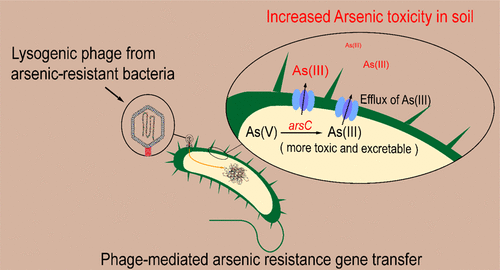当前位置:
X-MOL 学术
›
Environ. Sci. Technol. Lett.
›
论文详情
Our official English website, www.x-mol.net, welcomes your feedback! (Note: you will need to create a separate account there.)
Bacteriophages from Arsenic-Resistant Bacteria-Transduced Resistance Genes, which Changed Arsenic Speciation and Increased Soil Toxicity
Environmental Science & Technology Letters ( IF 10.9 ) Pub Date : 2019-10-25 , DOI: 10.1021/acs.estlett.9b00600 Xiang Tang 1, 2 , Pingfeng Yu 3 , Lin Tang 1, 2 , Man Zhou 1, 2 , Changzheng Fan 1, 2, 3 , Yue Lu 1, 2 , Jacques Mathieu 3 , Weiping Xiong 1, 2 , Pedro J. Alvarez 3
Environmental Science & Technology Letters ( IF 10.9 ) Pub Date : 2019-10-25 , DOI: 10.1021/acs.estlett.9b00600 Xiang Tang 1, 2 , Pingfeng Yu 3 , Lin Tang 1, 2 , Man Zhou 1, 2 , Changzheng Fan 1, 2, 3 , Yue Lu 1, 2 , Jacques Mathieu 3 , Weiping Xiong 1, 2 , Pedro J. Alvarez 3
Affiliation

|
Lysogenic phages are known to serve as transfer vectors for bacterial genes involved in biotransformation of various environmental pollutants. However, their role in arsenic-contaminated environments is largely undocumented. Here, lysogenic phages were chemically induced (with mitomycin C) in soil samples from two contaminated sites, and arsenic resistance genes arsC (coding for As(V) reduction to excretable (via efflux pumps) but more toxic As(III)) and arsM (coding for As(III) methylation) were detected in these phage genomes. The relative abundance of these genes (per phage particle) was positively correlated with that in the corresponding indigenous soil bacterial communities (resistance gene per 16S rRNA), with R2 = 0.974 for arsC and 0.761 for arsM. Microcosm studies with 100 mg/kg of arsenic soil showed that phages (amended at 5.0 × 107 phages per gram soil) enhanced the propagation of arsC by 122-fold and arsM by 575-fold, relative to unamended soil. This increased the As(III) concentration by 4.3 mg/kg (214%) after 15 days but also enabled arsenic methylation (to 0.8 mg/kg). Earthworm avoidance tests corroborated the increase in soil arsenic ecotoxicity after phage addition. Overall, this study demonstrates that arsenic resistance genes transduction by lysogenic phages can result in an overlooked but important phenomenon: a change in arsenic speciation and a significant increase in soil ecotoxicity.
中文翻译:

耐砷细菌转导抗性基因的噬菌体,改变了砷的形态并增加了土壤毒性
已知溶原性噬菌体可作为涉及各种环境污染物生物转化的细菌基因的转移载体。但是,它们在受砷污染的环境中的作用在很大程度上没有记载。在这里,从两个受污染地点的土壤样品中化学诱导了溶原性噬菌体(使用丝裂霉素C),以及砷抗性基因arsC(编码为As(V)还原为可排泄(通过外排泵),但毒性更大的As(III)和arsM在这些噬菌体基因组中检测到(编码As(III)甲基化)。这些基因的相对丰度(每个噬菌体颗粒)与相应的本地土壤细菌群落中的相对丰度(每个16S rRNA的抗性基因)呈正相关,其中R 2 = 0.974。arsC和arsM为0.761。用100 mg / kg砷土壤进行的微观研究表明,相对于未改良土壤,噬菌体(修正为每克土壤5.0×10 7个噬菌体)使arsC的繁殖提高了122倍,而arsM的繁殖提高了575倍。15天后,As(III)的浓度增加了4.3 mg / kg(214%),但也使砷甲基化(达到0.8 mg / kg)。worm避免测试证实了噬菌体添加后土壤砷生态毒性的增加。总体而言,这项研究表明,溶源性噬菌体对砷抗性基因的转导可导致被忽视但很重要的现象:砷形态的变化和土壤生态毒性的显着增加。
更新日期:2019-10-25
中文翻译:

耐砷细菌转导抗性基因的噬菌体,改变了砷的形态并增加了土壤毒性
已知溶原性噬菌体可作为涉及各种环境污染物生物转化的细菌基因的转移载体。但是,它们在受砷污染的环境中的作用在很大程度上没有记载。在这里,从两个受污染地点的土壤样品中化学诱导了溶原性噬菌体(使用丝裂霉素C),以及砷抗性基因arsC(编码为As(V)还原为可排泄(通过外排泵),但毒性更大的As(III)和arsM在这些噬菌体基因组中检测到(编码As(III)甲基化)。这些基因的相对丰度(每个噬菌体颗粒)与相应的本地土壤细菌群落中的相对丰度(每个16S rRNA的抗性基因)呈正相关,其中R 2 = 0.974。arsC和arsM为0.761。用100 mg / kg砷土壤进行的微观研究表明,相对于未改良土壤,噬菌体(修正为每克土壤5.0×10 7个噬菌体)使arsC的繁殖提高了122倍,而arsM的繁殖提高了575倍。15天后,As(III)的浓度增加了4.3 mg / kg(214%),但也使砷甲基化(达到0.8 mg / kg)。worm避免测试证实了噬菌体添加后土壤砷生态毒性的增加。总体而言,这项研究表明,溶源性噬菌体对砷抗性基因的转导可导致被忽视但很重要的现象:砷形态的变化和土壤生态毒性的显着增加。



























 京公网安备 11010802027423号
京公网安备 11010802027423号